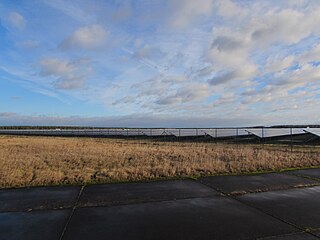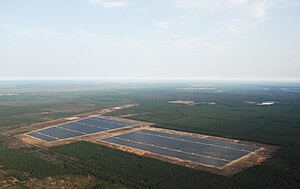
Many countries and territories have installed significant solar power capacity into their electrical grids to supplement or provide an alternative to conventional energy sources. Solar power plants use one of two technologies:

Spain is one of the first countries to deploy large-scale solar photovoltaics, and as of 2018, is the first country for concentrated solar power (CSP) in the world.

The Waldpolenz Solar Park is a 52-megawatt (MW) photovoltaic power station built by German developer and operator Juwi at a former military air base near Leipzig, Eastern Germany. When completed by the end of 2008, it was the world's largest thin-film solar park using CdTe-modules.

Solar power in Germany consists almost exclusively of photovoltaics (PV) and accounted for an estimated 8.2 percent of the country's gross-electricity generation in 2019. About 1.5 million photovoltaic systems were installed around the country in 2014, ranging from small rooftop systems, to medium commercial and large utility-scale solar parks. Germany's largest solar farms are located in Meuro, Neuhardenberg, and Templin with capacities over 100 MW.

The Erlasee Solar Park, or Solarstrompark Gut Erlasee, is an 11.4 megawatt (MW) photovoltaic power station located in Bavaria, southern Germany, in one of the sunniest regions of the country. Constructed on a former vineyard by the company Solon SE in 2006, it was then the world's largest photovoltaic power station.
Beneixama photovoltaic power plant is a 20 MW photovoltaic power plant located in Beneixama, Spain. The plant consists of approximately 100,000 solar panels, encompassing an area of approximately 500,000 m2. The panels are City Solar PQ 200 modules made of polycrystalline silicon solar cells. In addition, 200 units of Siemens photovoltaic inverters "Sinvert Solar 100 Master" were installed.

Gottelborn Solar Park is an 8.4-MWp photovoltaic power station located in Göttelborn, in Quierschied municipality, Germany. The power plant was constructed by City Solar in two stages. The first stage was completed in August, 2004, followed by the second stage three years later in November 2007.
The Olmedilla Photovoltaic Park is a 60-megawatt (MW) photovoltaic power plant, located in Olmedilla de Alarcón, Spain. When completed in July 2008, it was the world's largest power plant using photovoltaic technology.

Pakistan has some of the highest values of insolation in the world, with eight to nine hours of sunshine per day, ideal climatic conditions for solar power generation. However, the country has been slow to adopt the technology.

The Strasskirchen Solar Park is a large photovoltaic power station in Bavaria, with an installed capacity of 54 MW. It was developed by a joint venture of MEMC and Q-Cells in 2009. At this time this Solar Park was the second largest PV Power Plant. Q-Cells also provided the solar modules for the facility which is located in Straßkirchen, Bavaria, Germany.
The Köthen Solar Park is a photovoltaic power station in Köthen, Germany. It has a capacity of 45 megawatts (MW) and an expected annual electricity generation of 42 gigawatt-hours. The solar park was developed and built by RGE Energy.

The Eggebek Solar Park was Germany's largest photovoltaic power station when completed in August 2011, and one of the largest in the world. It is built on a 160 ha plot of land near the Eggebek municipality in Schleswig-Holstein state, Germany near the border with Denmark. The solar park has a power generation capacity of 83.6 MW and uses roughly 360,000 state-of-the-art multicrystalline solar modules of the TSM-PC05 series produced by the Chinese company Trina Solar.
Huanghe Hydropower's Golmud Solar park is a 200 megawatt (MW) photovoltaic power station located in Golmud, Qinghai Province, China. Construction began in August 2009, and it was commissioned on October 29, 2011. 80 MW was provided by Yingli. The project won the 2012 China Quality Power Project Award. Output is expected to be 317 GWh per year.

As of the end of 2014, solar power in Austria amounted to 766 megawatt (MW) of cumulative photovoltaic (PV) capacity, of which more than three quarters were installed within the last four years. Solar PV generated 766 gigawatt-hours, or about 1.4% of the country's final electricity consumption. As with most other European countries, 99.5 percent of all solar power systems are connected to the electrical grid. The nation's installed PV capacity by inhabitant stood at 91 watts, still below the European Union's 2014-average of 172 watts.

The Lauingen Energy Park is a 25.7–megawatt (MW) photovoltaic power station, located in Bavarian Swabia, Germany. It covers an area of 63 hectares and was commissioned in June 2010.
Ernsthof Solar Park is a photovoltaic power station near Dörlesberg, Wertheim, Germany. It has a capacity of 34.4 MWp making it the largest Solar Park in the state of Baden-Württemberg. Phase I of 6.88 MWp and covering an area of 16.6 hectares, consisted of 31,280 modules by LDK Solar Energy Systems was completed on March 30, 2010. The second phase of 7.25 MWp was completed in December 2010, and it was expanded to 29.5 MW and then to 34.4 MW, with over 120,000 modules being fitted in December. Ernsthof East is 6.8 MW and Ernsthof West is 27.5 MW. The total area is 85 ha. Ernsthof is part of the Tauberlandpark, a planned 72 MW solar park consisting of Ernsthof and Solarpark Gickelfeld, which has been delayed due to the political uncertainty of solar parks of over 10 MW receiving the FIT. They may need, instead, to sign a Power Purchase Agreement with the grid distribution power company, which is better than subdividing large projects into multiple smaller segments just to qualify for the FIT.
Reckahn Solar Park is a photovoltaic power station in Reckahn, southwest of Berlin, Germany. It has a capacity of 37.7 megawatt (MW) and was constructed in three phases. Reckahn I was 22.661 MW covering 56 hectares and was built by Beck Energy GmbH (Belectric) using 292,000 First Solar thin-film CdTe-panels, and was expected to produce about 22 gigawatt-hours per year. Reckahn II added 13.3 MW, using 172,000 modules on a 35 hectares site. Reckahn III, completed in 2011, added 1.8 MW, bringing the total to 37.7 MW. The FIT is 21.1 Euro cents per kilowatt-hour.

Brandenburg-Briest Solarpark is photovoltaic power station, located at a former military airfield in Brandenburg, Germany. At the time of its completion, it was the largest solar park in Europe. Equipped with Q-Cells solar modules, it consists of three sections, namely

Solarpark Meuro is a 166 megawatt (MW) photovoltaic power station located in Meuro and Schipkau, Germany. The plant was built on a former lignite mine and is the country's largest solar park. It was named POWER-GEN International solar project of the year in 2012.
















